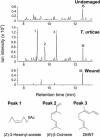Herbivore-induced defense response in a model legume. Two-spotted spider mites induce emission of (E)-beta-ocimene and transcript accumulation of (E)-beta-ocimene synthase in Lotus japonicus
- PMID: 15310830
- PMCID: PMC520769
- DOI: 10.1104/pp.104.042929
Herbivore-induced defense response in a model legume. Two-spotted spider mites induce emission of (E)-beta-ocimene and transcript accumulation of (E)-beta-ocimene synthase in Lotus japonicus
Abstract
Indirect defense of plants against herbivores often involves the induced emission of volatile infochemicals including terpenoids that attract natural enemies of the herbivores. We report the isolation and characterization of a terpene synthase cDNA (LjEbetaOS) from a model legume, Lotus japonicus. Recombinant LjEbetaOS enzyme produced (E)-beta-ocimene (98%) and its Z-isomer (2%). Transcripts of LjEbetaOS were induced in L. japonicus plants infested with two-spotted spider mites (Tetranychus urticae), coinciding with increasing emissions of (E)-beta-ocimene as well as other volatiles, (Z)-3-hexenyl acetate and (E)-4,8-dimethyl-1,3,7-nonatriene, by the infested plants. We suggest that LjEbetaOS is involved in the herbivore-induced indirect defense response of spider mite-infested L. japonicus via de novo formation and emission (E)-beta-ocimene. Mechanical wounding of the leaves or application of alamethicin (ALA), a potent fungal elicitor of plant volatile emission, also induced transiently increased levels of LjEbetaOS transcripts in L. japonicus. However, wounding or ALA did not result in elevated release of (E)-beta-ocimene. Differences in volatile emissions after herbivory, mechanical wounding, or treatment with ALA suggest that neither a single mechanical wounding event nor ALA simulate the effect of herbivore activity and indicate that herbivore-induced emission of (E)-beta-ocimene in L. japonicus involves control mechanisms in addition to up-regulation of LjEbetaOS transcripts.
Figures





References
-
- Akamine S, Nakamori K, Chechetka SA, Banba M, Umehara Y, Kouchi H, Izui K, Hata S (2003) cDNA cloning, mRNA expression, and mutational analysis of the squalene synthase gene of Lotus japonicus. Biochim Biophys Acta 1626: 97–101 - PubMed
-
- Arimura G, Huber DPW, Bohlmann J (2004) Forest tent caterpillars (Malacosoma disstria) induce local and systemic diurnal emissions of terpenoid volatiles in hybrid poplar (Populus trichocarpa x deltoides): cDNA cloning, functional characterization, and patterns of gene expression of (−)-germacrene D synthase, PtdTPS1. Plant J 37: 603–616 - PubMed
-
- Arimura G, Ozawa R, Nishioka T, Boland W, Koch T, Kühnemann F, Takabayashi J (2002) Herbivore-induced volatiles induce the emission of ethylene in neighboring lima bean plants. Plant J 29: 87–98 - PubMed
-
- Arimura G, Ozawa R, Shimoda T, Nishioka T, Boland W, Takabayashi J (2000) Herbivory-induced volatiles elicit defense genes in lima bean leaves. Nature 406: 512–515 - PubMed
Publication types
MeSH terms
Substances
Associated data
- Actions
- Actions
- Actions
- Actions
- Actions
- Actions
- Actions
LinkOut - more resources
Full Text Sources
Other Literature Sources
Molecular Biology Databases

